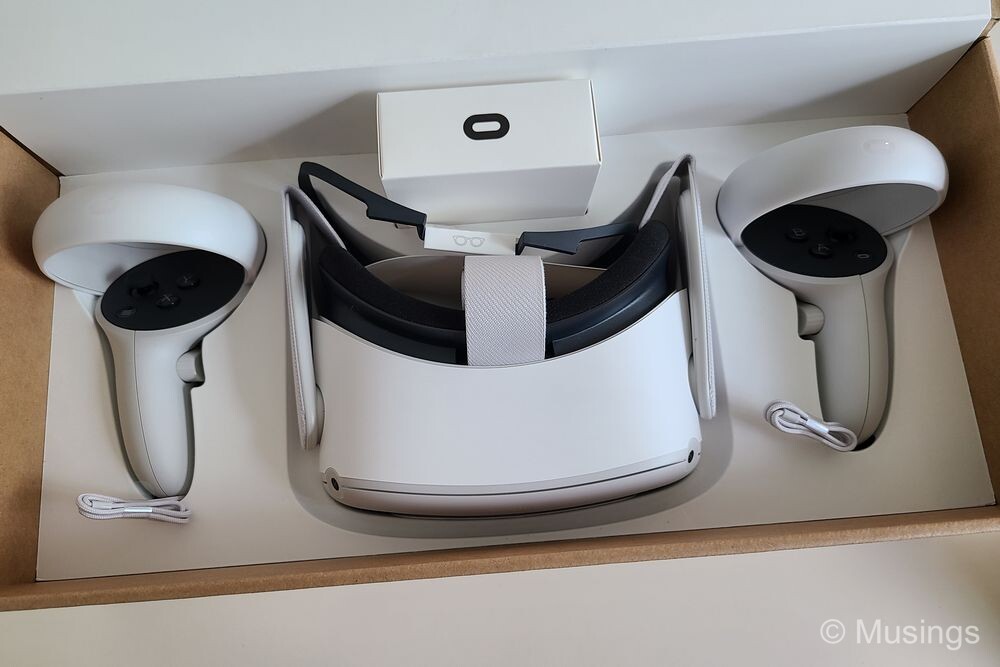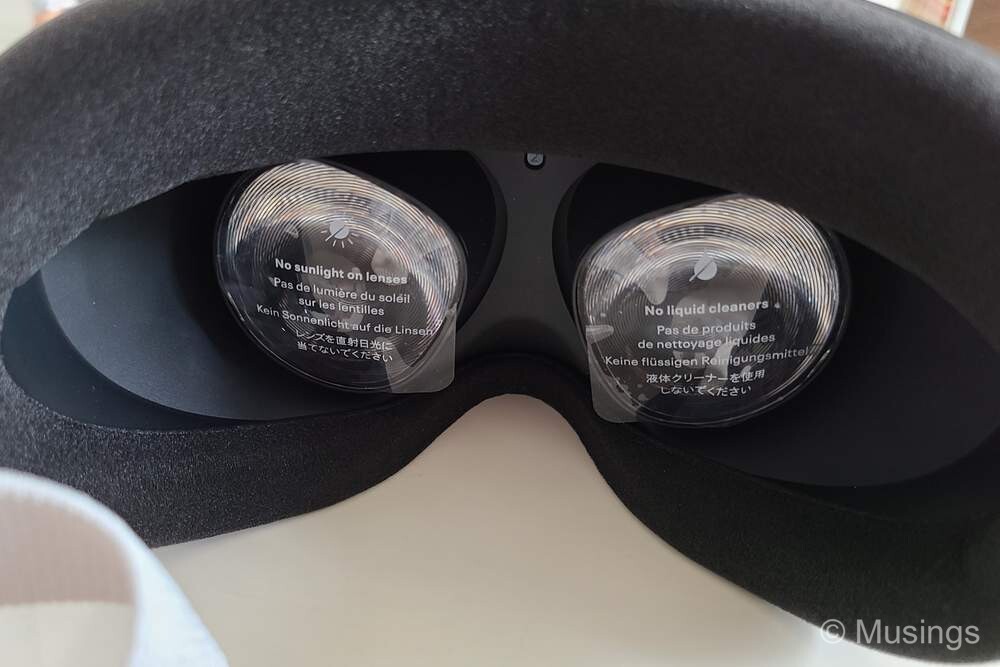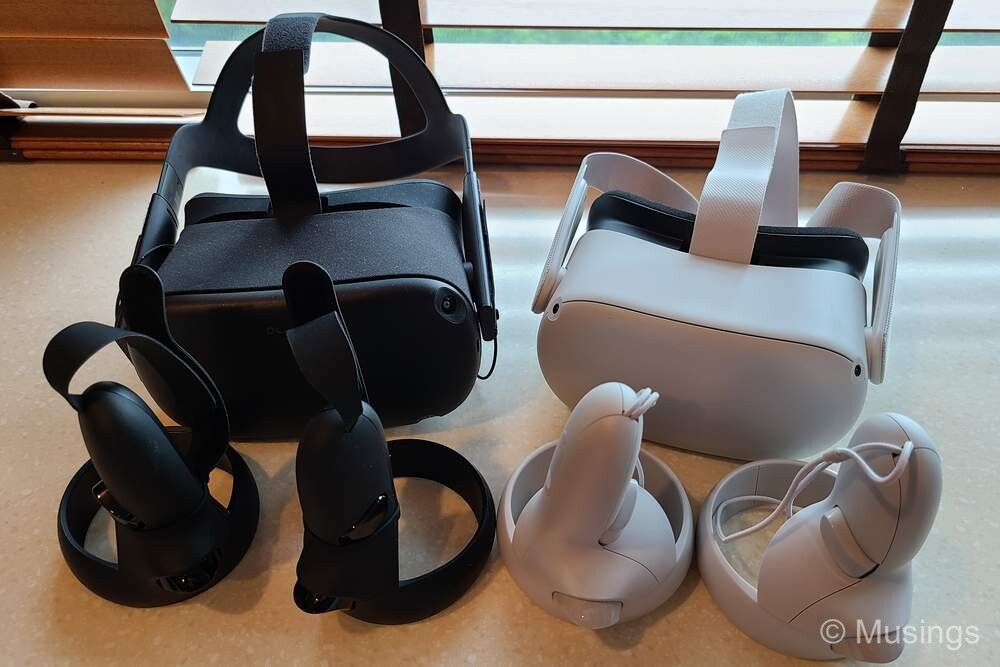Well, this wasn’t something I was expecting to receive: an Oculus Quest 2, and coming by way of the Christmas present from the wife and kids last month! The Quest 2 was announced by Facebook in September – just a month after I’d already picked up the Oculus Quest and also blogged about it here. I was actually even somewhat annoyed, especially since I wasn’t expecting a new edition of the headset to show up anytime in 2020 – an observation also shared by other tech gadget reviewers. If I’d known, I’d certainly have held off buying the original Quest at that point: if nothing else, because newer editions routinely come in more costly than their predecessors.
And that turned out to be the first shocker: the Quest 2 actually has a lower starting price than the Quest, and at a difference of USD100 even – USD299 vs USD399. The initial reviews of the Quest 2 were also largely positive, with many enthusiasts reporting that the increased resolution and pixel density in the eye displays were significantly improving the overall visual experience. But I wasn’t finally planning to get the Quest 2, impressive as it was – only because the Quest I had on hand was fine (limitations and all), and just barely 2 months in.

So, personal notes aside, now we’ve got two Quests at home. And after a week of use, here are comments on the Quest 2 – and in many cases, against the original Quest.
Specs-wise, the Quest 2 is lighter: 503 grams compared to the original Quest’s 571 grams. You can feel the weight difference in hand, but once it’s mounted on my head, the difference is negligible, and both still feel front-heavy and bulky to wear. Headsets will continue to get lighter and less large over time as VR tech improves, but for the moment, you’re unlikely to forget that you’re wearing a VR headset even when you’re deeply immerse in gameplay.
The Quest 2 also comes in two flavors: the basic 64GB edition, and 256GB one which is what I got. The 64GB I had on my original Quest was actually perfectly sufficient, since that storage is easily enough for the dozen decent-sized games I’ve got loaded on it at any one time. The 256GB makes it more future proof for VR games with huge storage footprints, but it finally also seems more oriented towards VR media consumers – which I’m not. Oh well. At least I can now load up all manner of junk onto the Quest 2 and never have to remove it now to make space available!
I’ve got mixed feelings about the redesigned controllers. While they come in a nice white color to match the new headset, they also feel far more slippery on account that the controller surfaces are now smooth. The original Quest coated its controllers with a somewhat grainy texture which aided in gripping. Thankfully, with wrists straps, the controllers won’t be flying off your hands anytime – but these new controllers now feel like you’re carrying bars of soap.
There’s been a lot of complaints about the design of the head strap on the new headset too, which some enthusiasts joking that the Quest 2 doesn’t start at USD299 – but USD299 + USD40, on account that most users will want the USD40 improved strap that is purchased separately. Personally, I didn’t find the strap discomforting. The problem of it for me though is that the back strap that tightens the headset when you wear it comes loosens easily. Which means that in extended sessions, you’d need to pause your play every now and then to re-tighten the back headstrap.
The redesigned Quest 2 also requires new accessories – bummer. It now has a single audio jack compared to the dual audio jacks used on the original Quest, and a new all important silicon face cover is needed too – unless you like the headset foam padding to soak in all your perspiration over time.
The IPD – Inter-Pupillary Distance – slider that previously sat on the bottom of the original Quest has been replaced by a mechanism in the Quest 2 where you manually move the eyelenses now. The issue with this new design is that the slider is now in three fixed positions, compared to the large number of graduations on the original Quest. It wasn’t that much of a problem though for me since I adjust the IPD slider all the way to the extreme and leave it there permanently since I’m the primary user of the Quests. But if you’re passing your headset from person to person, then having to take your headset on and off to adjust the IPD setting is a hassle.

The new Quest also comes with a better processor – Qualcomm Snapdragon XR2 vs Qualcomm Snapdragon 835 – and support for higher refresh rates – 90Hz vs 72Hz. However, games will need to be released to actually make use of that beefier processor and 90Hz refreshes, and that might take a while. For the moment, the games I’ve bought for the Quest don’t seem to offer better performance frame-rate wise on the Quest 2.
And of course, there are the higher-resolution eye displays – now rated at 1832 x 1920 per eye, compared to the 1400 x 1600 pixels on the original Quest. The increased pixel density is immediately obvious when the Quest 2 dashboard loaded up, and the screen door effect – or visible space between pixels – is much less now. Basically, everything looks crispier now on the new headset. There’s a serious challenge with these new eye-displays though, and that’s the underlining technology used: LCD compared to the OLEDs on the original Quest. Basically, non-OLED display aren’t capable of showing ‘true’ blacks well – blacks routinely look washed-out, and the display technology limitation was evident as soon as I was looking at content with dark settings. It’s not an issue for most of the games I’ve got, but for it was particularly obvious in the Star Wars: Vader Immortal series I’ve been playing.
The built-in speakers are also improved from the original Quest, though I’m hard-pressed to tell the audio differences coming out of any improvements. The problems are on the other hand retained: there’s still significant sound leakage – i.e. people around you can here what you’re up to, which could be a good (or bad) thing – and I routinely have to set the speakers to near or at maximum levels in order to hear content.
That’s the long and short of the initial comments from the new Quest 2. On the overall, it’s a pretty good device. If you’re new to VR, the 64GB edition of the Quest 2 now would be an easy recommendation: it’s relatively affordable, and providing crisp visuals that are finally at the point where you’re not routinely spotting pixels. That said, it’s less of a good buy if you already have the original Quest though: the improvements are nice, but the earlier headset is still perfectly fine for the content that’s already available.

My next post in this series will look at more VR content for the two Quests I’ve got now.:)
Recent comments